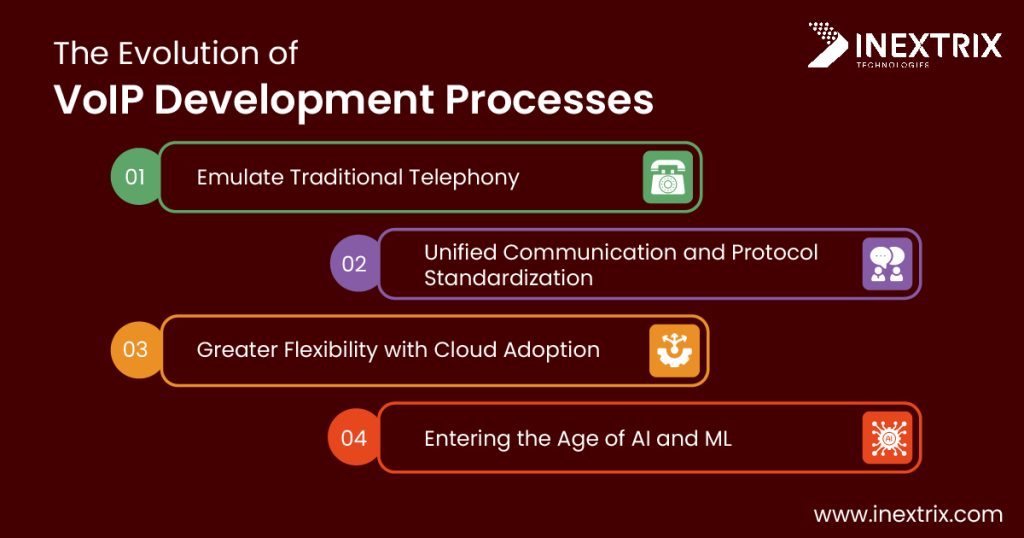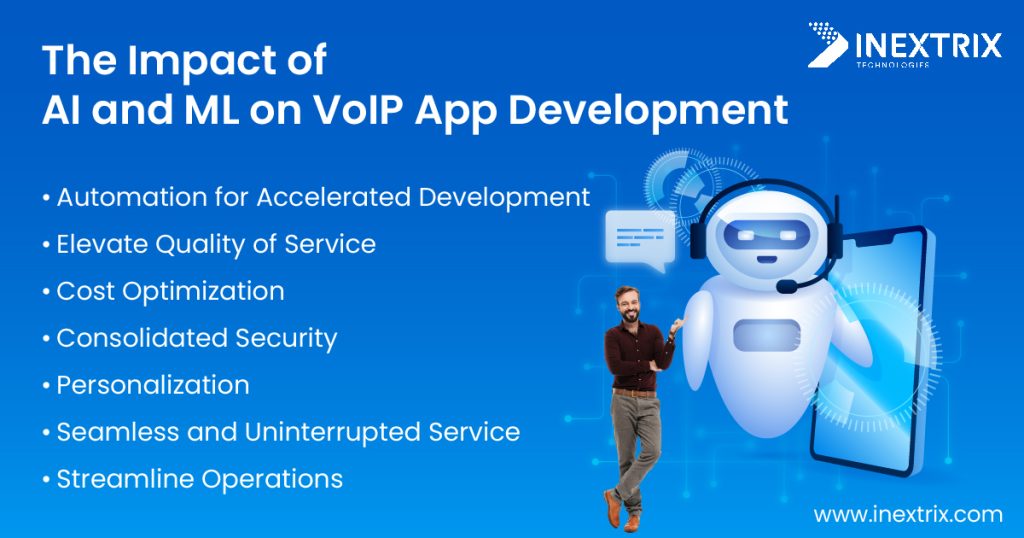The convergence of Artificial Intelligence (AI) and Machine Learning (ML) with VoIP technology marks a pivotal shift towards more intelligent, efficient, and personalized communication solutions. This fascinating fusion has commenced a new era in VoIP development. This era transforms the development process with AI and ML, which will redefine the capabilities and potential of VoIP based telecommunication solutions. We stand at the entrance of an exciting journey into the future of telecommunications, one that promises unparalleled advancements in how businesses connect, communicate, and collaborate.
AI and ML have outstanding ability to learn, adapt, and make data driven decisions. Moreover, these technologies are set to revolutionize VoIP solution development methodologies by enhancing call quality, bolstering security measures, automating administrative tasks, and offering personalized user experiences.
Transform your communication with our advanced VoIP development services.
These technologies are pushing the boundaries of what’s possible with VoIP. As a result, it has turned into a smarter platform capable of addressing the complex demands of today’s digital age. AI and ML are at the forefront of this transformative wave. Moreover, the integration of ML and AI in VoIP is catalyzing a shift towards more context driven communication systems. These systems can understand the nuances of human interaction. Furthermore, it enables more meaningful and productive conversations.
In short, this means access to VoIP solutions that can analyze call data, predict customer behavior, and deliver insights that drive strategic decision making and improve customer service for businesses. Conversely, for individuals, it translates to richer, more reliable communication experiences that seamlessly integrate with their digital lives.
In this blog post, we are going to cover more details about the development process that is positively influenced by AI and ML technologies. Let’s delve deeper into this subject matter to explore how the future is getting redefined.
1. What is VoIP Software Development?
Before understanding the influence of ML and AI in VoIP system development process, it is necessary to understand the development process in brief.
VoIP software development actively involves designing, developing, and maintaining applications that facilitate VoIP communication to businesses and end users. The development companies use different VoIP technologies and other programming frameworks to build the backend and frontend of the solutions. Firstly, the development process aims to build an easy to use and GUI based application. Secondly, the built solution must include the necessary features to meet predefined communication needs. Finally, it harnesses the potential of advanced and cutting edge technologies to boost communication potential and give a competitive edge to providers and users of these communication solutions.
The aim of developing VoIP software is to deliver efficient, cost effective, and adaptable communication solutions that seamlessly integrate with other online services and applications. Thus, it redefines the way we connect.
2. Evolution of the Development Process in VoIP

The VoIP industry has evolved over time and so does the development process. Let’s look at some of the major transitions witnessed in this process.
Emulate Traditional Telephony
Initially, VoIP development primarily focused on replicating the functionalities of traditional telephony within the digital world. Undoubtedly, developers tackled significant challenges in the process. For example, some of the challenges include latency and packet loss. To ensure that voice quality over unpredictable IP networks matched the reliability of circuit-switched telephone networks. This phase introduced the foundational blocks, which emphasizes the establishment of a stable and functional VoIP system that could rival traditional phone services in terms of clarity and reliability.
Unified Communication and Protocol Standardization
The development process in the VoIP industry entered a transformative phase. Certainly, it expands its scope beyond voice transmission to include unified communication capabilities. Video calling, instant messaging, and file sharing have become integral parts of VoIP solutions. This increases broadband adoption and the desire for more comprehensive communication tools. This era also witnessed the critical standardization of protocols like SIP. Moreover, it enables different VoIP systems to interact seamlessly and enrich the user experience with diverse functionalities.
Greater Flexibility with Cloud Adoption
Unquestionably, the advent of cloud computing marked a significant turning point in the development process of VoIP. Developers began harnessing cloud platforms to enhance VoIP services’ scalability, flexibility, and cost efficiency. Firstly, this shift allowed businesses to deploy sophisticated communication systems without the burden of heavy on-premises hardware. Secondly, it streamlines management processes. Thirdly, it facilitates easier and better scalability. Cloud-based VoIP solutions represented a move towards more agile and manageable communication infrastructures that could dynamically adjust to varying business needs.
Entering the Age of AI and ML
Today, Artificial Intelligence and Machine Learning are profoundly influencing the development process in the VoIP industry. Certainly, it marks the sunrise of intelligent communication solutions such as a smart telephony platform.
AI and ML are augmenting VoIP with new features. Moreover, these technologies are revolutionizing the very fabric of VoIP technology. Through analyzing patterns, optimizing call quality, and personalizing experiences, AI and ML are turning VoIP platforms into smart, adaptive systems. AI and ML have smart features like voice recognition, real time language translation, and sentiment analysis during calls that are pushing the boundaries of what’s possible. Unquestionably, this signifies a future where VoIP services are inherently intelligent, context-aware, and capable of providing unprecedented levels of user engagement and satisfaction.
3. Role of AI and ML in VoIP App Development

We have already entered an era of development that is influenced by AI and ML technologies. There are already several tools and algorithms built using these technologies, which are ready to be integrated into the VoIP based communication solutions. Moreover, these technologies can influence and improve the development process, too.
Automation for Accelerated Development
At the cutting edge of innovation, AI and ML are reshaping VoIP app development by automating intricate development tasks. For example, it can automate algorithmic and logical coding to speed up the process. Moreover, it automates debugging.
In short, AI and ML technologies reduce manual coding errors, streamline the development lifecycle, and significantly expedite the time to market for new VoIP features and applications. Moreover, these technologies automate the developer-intensive aspects of testing and quality assurance. Additionally, it deploys sophisticated algorithms to simulate various network conditions and user scenarios. As a result, it ensures that VoIP solutions are not only robust but also of the highest quality upon release.
Elevate Quality of Service
AI and ML excel in optimizing voice quality. The algorithms developed using these technologies seamlessly analyze network data in real time to select the best possible carriers and routes for each call. Moreover, it involves sophisticated algorithms that assess bandwidth availability, latency, and packet loss across different network paths. As a result, it makes real time decisions to reroute traffic as necessary. This adaptability ensures that VoIP calls maintain crystal clear quality even in fluctuating network conditions. In short, it vastly improves the user experience.
Cost Optimization
The strategic analysis capabilities of AI and ML extend to financial efficiency. Moreover, it offers detailed predictions to VoIP providers on cost saving routes without compromising call quality. Furthermore, it leverages historical data and real time analytics. Therefore, these systems forecast network traffic patterns and pricing fluctuations. It enables providers to choose the most economical routes. This reduces operational expenses. Moreover, it allows providers to offer competitive pricing. As a result, it enhances their market position.
Consolidated Security
Significantly, AI and ML enhance the security framework of VoIP applications. It continuously monitors communication patterns and network traffic. Therefore, these systems can detect anomalies that may indicate security breaches or fraudulent activities. Ideally, advanced machine learning models are trained to recognize the subtle signs of such threats. Therefore, it enables them to respond instantly to neutralize risks and maintain the integrity of VoIP communications.
Personalization
AI and ML take personalization to new heights in VoIP applications. Beyond smart call routing, these technologies analyze user preferences, communication habits, and even voice commands to customize the VoIP experience uniquely for each user. Interestingly, this level of personalization builds a deeper connection between users and the VoIP service. As a result, it leads to increased satisfaction and loyalty.
Seamless and Uninterrupted Service
The proactive stance of AI and ML on maintenance helps VoIP providers preemptively address potential system issues. By monitoring hardware performance and network connectivity, predictive models can identify the early signs of system failures or disruptions. As a result, it allows timely maintenance or upgrades. Certainly, this foresight minimizes service interruptions. Therefore, providers can ensure reliable VoIP communication for users.
Streamline Operations
Unquestionably, AI and ML provide VoIP providers with invaluable insights into their operations. This data includes user behavior, call quality metrics and system performance. These technologies uncover trends and patterns that inform strategic decisions. This data driven approach enables continuous optimization of VoIP services. Therefore, it drives innovation and ensures that providers remain at the forefront of the VoIP industry.
Recommended Reading, role of AI and WebRTC technologies on VoIP based telephony industry. Learn how these two technologies are redefining the new heights of quality and personalization for VoIP communication solution users.
4. Major Benefits of Implementing AI and ML into VoIP Programming
Definitely, the integration of AI and Machine Learning into VoIP solution development brings distinct advantages that outstandingly improve product delivery and customer experience.
Reduced Time to Market
AI and ML streamline the development process by automating repetitive and time-consuming jobs. These technologies enhance efficiency for all development operations, ranging from coding to testing. Moreover, it keeps developers available to focus on innovation and critical problem solving tasks. As a result, it accelerates the development of the lifecycle. Therefore, VoIP solutions can reach the market faster, meet customer needs more promptly, and respond agilely to industry changes.
Gain a Competitive Edge
Certainly, leveraging AI and ML can offer advanced features such as intelligent call routing, real time voice translation, and predictive maintenance. These cutting-edge functionalities differentiate VoIP products in a crowded market. Therefore, AI and machine learning driven development provides a significant competitive advantage. Moreover, businesses that adopt AI and ML in their development projects are better positioned to lead with innovative solutions, attracting and retaining customers.
Reduced Development Cost
AI and machine learning in the development process expedite the process. Moreover, it contributes to cost reduction. For example, automated testing reduces the need for extensive manual testing. As a result, it lowers labor costs. On the other hand, predictive analytics optimize resource allocation. Therefore, it prevents wasteful expenditure. By improving efficiency and reducing errors, AI and ML minimize rework and associated costs. As a result, it makes the development of VoIP solutions more affordable.
Increased Customer Satisfaction
The integration of AI and ML into the development process in the VoIP industry directly contributes to enhanced user experiences. Certainly, personalized services, improved call quality, and innovative features meet and exceed customer expectations. Moreover, automated customer support and proactive problem resolution ensure issues are addressed swiftly. Additionally, it increases customer satisfaction and loyalty. Unquestionably, happy customers are more likely to recommend services to others. As a result, it further contributes to a positive cycle of growth and customer retention.
Concluding Note
The potential of AI and ML to enhance the development process is much more than just improving existing features. Firstly, it redefines the future of communication in an interconnected world. Secondly, the journey ahead is filled with possibilities, challenges, and opportunities to innovate. Finally, it is a journey that promises to transform VoIP technology into a cornerstone of digital communication for years to come. Undoubtedly, AI and ML are strategic tools that drive faster development, competitive differentiation, cost efficiency, and customer satisfaction in the VoIP industry. Therefore, the influence of these two technologies is increasing tremendously.
To implement AI and Machine Learning into the development process, it is necessary to have good knowledge of different algorithms, tools, and integration processes. This can ensure better output at lower expenses rather than going the other way around. We have been helping businesses with our extensive experience in AI and ML driven development processes. If you are interested in harnessing the power of AI and machine learning for VoIP development, then contact us now.

